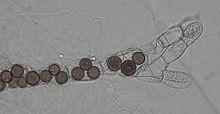Rozellida
| Rozellida | |
|---|---|

| |
| Rozella allomycis parasitizing the chytrid Allomyces sp. | |
| Scientific classification | |
| Domain: | Eukaryota |
| (unranked): | Opisthokonta |
| (unranked): | |
| Kingdom: | Fungi |
| Phylum: | Rozellomycota James & Berbee 2011 ex Doweld 2013[1]
|
| Class: | Rozellidea Cavalier-Smith 2013
|
| Order: | Rozellida Cavalier-Smith 2013 non Lara et al. 2010
|
| Family: | Rozellidae Cavalier-Smith 2013
|
| Genus | |
| Synonyms | |
| |
Cryptomycota ('hidden fungi'), Rozellida, or Rozellomycota are a
fungi or a sister group to fungi. They differ from classical fungi in that they lack chitinous cell walls at any trophic stage in their lifecycle, as reported by Jones and colleagues in 2011.[2][3] Despite their unconventional feeding habits,[clarification needed] chitin has been observed in the inner layer of resting spores, and in immature resting spores for some species of Rozella, as indicated with calcofluor-white stain as well as the presence of a fungal-specific chitin synthase gene.[4]
Rozellida were first detected as
Phylogenetic analysis of these sequences formed a unique terminal clade of then unknown affiliation provisionally called after the first clone in the clade: LKM11.[5]
The only formally described genus in the clade is Rozella, which was previously considered a
chytrid. The existence of related organisms was known from environmental DNA sequences.[6]
Additional members of the group were isolated in 2011 by a team led by Thomas Richards, from the
ovoid in shape and 3–5 micrometres across. They then established that the cryptomycota were present in other samples taken from further freshwater environments, soils and marine sediments.[7][8]
The common characteristic of the clade members is that they lack the chitinous
phagotrophic parasites that feed by attaching to, engulfing, or living inside other cells. Most known fungi feed by osmotrophy—taking in nutrients from outside the cell.[7]
Phylogeny
Phylogeny of Rozellomycota[9]
Fungi
|
| |||||||||||||||
